Stakeholders Respond to Mass. Proposal to Limit Cost Recovery for Gas Expansion
Business groups and environmental advocates expressed divergent views on a proposal by the Massachusetts Department of Public Utilities that would require new gas customers to cover the entire cost of connecting to the system.
The department’s draft policy would end the utility practice of including the costs of connecting new customers into rate base. This is currently allowed if the utility expects to recover the costs through distribution fees from the new customers over an extended period.
The AGO and a range of environmental nonprofits called for the DPU to add language establishing strict criteria for the exemptions that would allow a project’s connection costs to be covered by ratepayers.
“The draft policy should establish a clear and consistent methodology for assessing a demonstrable reduction in GHG emissions for proposed line extensions serving new construction,” wrote a coalition of environmental groups led by Rewiring America and the Acadia Center.
To read the full article from RTO Insider, click here.
Myth Busting: Congestion Pricing – Part II
Last July, Acadia Center published a myth busting blog tackling the controversial implementation of congestion pricing in New York City. Congestion is a policy designed to reduce traffic in the most congested areas of cities by charging vehicles a fee to enter designated areas. In New York, the plan imposed a charge on vehicles entering the highly congested lower part of Manhattan below 60th Street, aiming to cut down on traffic, improve air quality, and drive people toward the readily available public transit network, all while increasing funds for the Metropolitan Transportation Authority (MTA). Now that the policy has been in place for several months, it’s time to review just how effective it has been and what lessons can be learned.
So, has congestion pricing actually alleviated traffic congestion in NYC?
YES! The Congestion Pricing or Central Business District Tolling program, introduced on Jan 5, 2025, has led to noticeable and quantifiable reductions in traffic congestion within lower Manhattan.
Early numbers from the Metropolitan Transportation Authority (MTA) reported that since congestion pricing began in January 2025, traffic entering Manhattan’s Congestion Relief Zone has significantly declined. Compared to historical averages:

- January 2025 saw 8% fewer daily vehicle entries, totaling 1.27 million fewer vehicles for the month.
- February 2025 saw a 12% drop, or about 2.03 million fewer vehicles.
- March 2025 saw a 13% reduction, with 2.54 million fewer vehicles compared to baseline levels.
These sustained month-to-month reductions in traffic entering lower Manhattan suggest that congestion pricing effectively decreases traffic. Although some worried that congestion pricing would simply shift traffic to other boroughs, data shows that this hasn’t happened, there has been no noticeable increase in traffic in areas like the Bronx or Staten Island according to Streetsblog NYC.
Beyond the raw numbers, commuters and travel services have also reported improved travel speeds and increase public transit ridership. According to Better Cities, the MTA is averaging 448 thousand more public transit riders per day this year, that growth alone is nearly 50% larger than the total daily ridership of DC’s Metro, the second-busiest subway system in the U.S.
The biggest ridership growth has been in bus ridership. Since Bus speeds across the Hudson and east river entrances to Manhattan are faster, ridership has increased service has increased. According to Streetsblog NYC, buses have started to move so much faster in NYC that the MTA has had to modify the bus schedules to reflect earlier arrival times.
Since congestion pricing began in NYC, how much has it raised for the MTA?
On Feb 2025, the MTA released a statement on revenue from congestion pricing:
“Since the first-in-the-nation program began on Sunday, Jan. 5, through Friday, Jan. 31, tolls from the CRZ generated $48.66 million in revenue with a net $37.5 million putting the program on track to generate the $500 million that the MTA initially projected. The MTA will continue to report revenues from this program monthly.”
According to the MTA, revenue generated from the Congestion Relief Zone will fund some of the region’s most important transit capital projects, including:
- Accessibility improvements at over 20 stations
- Modern signal systems on segments of the A/C and B/D/F/M lines for over 1.5 million daily riders
- Hundreds of new electric buses
- Second Ave Subway Phase 2 extension to East Harlem
- Critical projects that keep our system in good working condition, such as structural repairs, power system improvements, and upgrades to bus depots.
Has there been any impact on crime rates on public transit? Has the increased use increased or decreased criminal activity in the city?
Despite the increase in subway ridership, crime on the NYC subway system has declined. According to recent NYPD data reported by AMNY, felony crimes on the subway dropped 15%, in the first quarter of 2025. There were 437 felonies recorded from January through March, compared to 515 during the same period in 2024. The data suggests that increased transit use has not led to more crime, in fact, more eyes on the street may coincide with a safer system overall. On top of that the funds from congestion pricing will likely be used to improve infrastructure and fare gates that will continue to increase safety in the system.
Will the new administration be able to force the end of congestion pricing?
The Trump administration has stated opposition to the Congestion Pricing Program in NYC, with the US transportation secretary, Sean Duffy, demanding its termination. However, the MTA has filed a lawsuit challenging the federal government’s decision. The latest reporting from ABC News mentions that “Hochul and MTA Chair and CEO Janno Lieber have said they will not turn off the tolls without a court order.”
Powering the Future: Why Transmission Planning in New England Matters for Consumers and Communities
This blog is a follow-up to the Acadia Center and National Resource Defense Council’s joint blog from September 2024, available here.
The New England region needs to plan the power grid of the future and build new transmission lines, which carry power from power plants to our homes, schools, and businesses. New transmission lines will help New England meet peak energy demand—which will double in the next century[1]—by allowing new clean energy resources to plug in to the grid and delivering low-cost power across the region. The rate of transmission build-out needs to double by 2032 to achieve a clean energy future.[2]
Not all transmission is created equal, and New England has a problem with too much of the wrong thing: ballooning costs for small, local transmission projects are eclipsing larger, multi-state, high-voltage projects. These small projects slip through regulatory “gaps” and have minimal oversight, costing millions just to maintain the existing system – and with little to no eye toward optimizing rebuilds for the future we need.[3] In contrast, well-planned, large regional lines can address multiple needs at once, saving consumers money. Maintenance of the existing system is important, but it can’t discourage the region from pursuing larger, multi-value projects (i.e., bringing reliability, economic, and public policy benefits).
The New England states realized the importance of large regional transmission, coming together with the regional grid operator, ISO New England (ISO-NE), to create the new “Longer-Term Transmission Planning Process”[4], or LTTP. This process is well underway, and ISO-NE just issued in late March 2025 its first solicitation[5] for transmission solutions that will unlock renewable energy in northern Maine and fix longstanding bottlenecks between northern and southern New England. In Northern Maine, there is critical renewable capacity from onshore wind and solar waiting to be unbottled from existing transmission constraints – which would provide reliable, affordable renewable energy that would flow to ratepayers in Maine and the rest of the region.
A winning project will be selected based on its “benefit to cost” ratio, which must be greater than 1—in other words, benefits must outweigh costs to New England residents. The good news: the six states have already agreed on a means of sharing costs of any LTTP transmission investments based on load allocation, making it a valuable deal for any individual state. Proposals will be published in November 2025, and the ISO and states will move forward with a final selection by September 2026[6]. The ISO and New England states are showing strong leadership, sprinting ahead of other regions to achieve state goals and build transmission that will benefit the region for generations to come.
Transmission projects need meaningful community engagement
Like any big infrastructure project, transmission lines need to consult and engage with the communities they pass through. Insufficient community engagement can exacerbate environmental justice harms and community impacts and cause projects to fail: analysis from the Niskanen Center and the Clean Air Task Force shows that local opposition has contributed to nearly 1/3 of U.S. transmission projects being delayed and/or cancelled.[7] And, 15% of counties nationwide have passed bans, moratoria, or other regulations that effectively limit clean energy;[8] clearly, with these sentiments on the rise, both transmission and other energy infrastructure projects are at-risk without meaningful plans to address community sentiment and preferences. New England is not immune to these trends: community opposition arose as an acute challenge during the last major procurement for new transmission lines in the region (Massachusetts’ 83D procurement in 2018)[9]. Simply put, projects will not be successful without top-notch community engagement.
While ISO-NE’s solicitation states that it will evaluate and credit applicants who submit a community engagement plan, the RFP falls short by not requiring all applicants to submit such a plan. The ISO should solicit projects that are following best practices for community engagement. There are already examples for New England: the Northern Plains Connector project worked with local community foundations to create a community-led philanthropic distribution process[10], and the Vineyard Wind project hired a trusted translator who spoke fluent Portuguese to communicate with the affected community.[11]Without requiring projects to submit robust community engagement plans, the LTTP process risks falling short of its important and meaningful transmission goals.
Other Considerations
Additionally, other important elements are included within the LTTP RFP but could be bolstered, like provisions for grid-enhancing technologies and using existing rights of way. Grid-enhancing technologies encompass multiple software and hardware technologies, but currently the RFP only specifies dynamic line ratings. Grid-enhancing technologies are low-cost and high-efficiency technologies that can make existing and new transmission lines more efficient; including them and incentivizing them more, as well as integrating them with forward-looking weather projections, would make this process even more beneficial for ratepayers. There’s a similar line of thinking for rights of way – utilizing existing rights of way like highways or existing transmission corridors can streamline new transmission permitting, and the RFP could be strengthened by showing in Part 2 that project applicants will be evaluated favorably if they can show the use of an existing right of way (with a potentially faster in-service date).
Conclusion
In sum, the LTTP process is important and is worth paying attention to for the region as it moves along. Bids for the LTTP RFP will be submitted by September 2025, and a summary of the bids will be posted publicly by November 2025. It will be critical for stakeholders to pay attention to the bids selected and see how these hopefully multi-value, robust transmission proposals create a resilient and affordable energy future for the Northeast.
[1] The Energy is About to Shift – Acadia Center and Clean Air Task Force Report. The Energy is About to Shift – Acadia Center
[2] Princeton University, Zero Lab Analysis – Electricity Transmission is Key to Unlock the Full Potential of the IRA. Sept 2022. REPEAT_IRA_Transmission_2022-09-22.pdf
[3] Claire Wayner, Kaja Rebane, and Chaz Teplin, Mind the Regulatory Gap: How to Enhance Local Transmission Oversight, RMI, 2024, https://rmi.org/insight/mind-the-regulatory-gap
[4] Lang-Ree, Claire and Poplavska, Anya, Bridging the Gap: New England’s Transmission Planning and Order 1920. New England’s Transmission Planning Opportunity, September 2024
[5] https://www.iso-ne.com/static-assets/documents/100021/2025lttprfp_postingannouncement.pdf
[6] Note that some potential flexibility is allocated before and after depending on 1) the number of proposals received and 2) what proposal the states prefer
[7] A closer look at the role of litigation and opposition in transmission projects undergoing federal permitting – Niskanen Center; this analysis examined 37 total projects nationwide according to key criteria
[8] Weise, E., Beard, S., Bhat, S., Radilla, R., Procell, C., & Zaiets, K. (2024, February 27). US counties are blocking the future of renewable energy: These maps, graphics, show how. USA Today. https://www.usatoday.com/story/graphics/2024/02/04/us-renew able-energy-grid-maps-graphics/72042529007/
[9] 83D – Massachusetts Clean Energy
[10] Community Benefits Snapshot: North Plains Connector Transmission Line Community Engagement and Benefits | World Resources Institute
[11] Who is Vineyard Power? — Vineyard Power
The Constitution pipeline will not solve wintertime energy price hikes
From 2014 to 2016, residents of Massachusetts, New York, New Hampshire, and Connecticut successfully blocked construction of the Kinder Morgan/NED and Constitution pipelines due to their environmental destruction capabilities and irresponsible use of eminent domain. Residents of Massachusetts, Pennsylvania, and New York defeated the Constitution pipeline in 2016, a decision supported by the courts in 2020.
A recent Acadia Center article noted:
Since 2018, existing gas customers have footed the bill for 80% of all new gas … connections. And these subsidies … are driving up gas bills for everyone. In 2023 alone, Massachusetts gas customers were charged $160 million to add new customers … to the tune of $9,000 per new customer, which is reflected on ratepayer gas bills.
To read the full article from the Berkshire Edge, click here.
Fuel Rates, Mandates, Tariffs Add Punch to Energy Price Stew
As Massachusetts Democrats predict price shocks from President Donald Trump’s threatened tariffs on Canadian oil and gas, a Republican senator on Tuesday blamed ballooning ratepayer costs on the state’s clean energy mandates.
In response to Tuesday’s presser, the Acadia Center said high natural gas costs this winter stem from the New England region’s “untenable over reliance on fossil fuels, with rising energy burdens driven by natural gas infrastructure, generous utility profits, and the region’s continued fossil fuel investments.”
“Right now, the region has almost all its eggs in the fossil fuel basket, and this offers only the false promise of fool’s gold in protecting the region’s consumers from rising energy bills,” the Acadia Center said. “The region must double down on its climate and clean energy goals to make the broader northeast region energy independent from fossil fuels, reduce consumer price spikes, and mitigate the economic harms of worsening climate change.”
To read the full article from State House News, click here.
ISO-NE Consumer Liaison Group Discusses Benefits of Energy Efficiency
PROVIDENCE — Speakers at the ISO-NE Consumer Liaison Group on March 27 discussed the system-wide costs and emissions benefits of energy efficiency and demand flexibility and called on policymakers to double down on efficiency programs as energy demand grows.
State energy efficiency programs have faced some political scrutiny in recent months amid high winter energy costs. To help reduce near-term electricity costs, the Massachusetts Department of Public Utilities in late February directed utilities to shave $500 million off the upcoming three-year plan for the Mass Save energy efficiency program.
Jamie Dickerson, senior director of climate and clean energy programs at the Acadia Center, said energy efficiency is responsible for a roughly 15% reduction in the region’s overall power demand and has brought more than $55 billion in benefits to the region since 2012.
He said it’s unfortunate energy efficiency “has emerged as a scapegoat for some,” given the cost reductions it can provide. Moving ahead, he emphasized the importance of energy efficiency as peak loads increase and estimated that achieving 20% demand flexibility in winter could save the region about $8 billion in transmission spending by 2050.
To read the full article from RTO Insider, click here.
A New Bill in Rhode Island Would Give Electric Ratepayers More Resources to Fight Back
The Rhode Island Public Utilities Commission on Friday voted to approve Rhode Island Energy’s proposed summer rates for residential customers, saying customers can expect relief following costly winter bills.
But the new rates have been met with such backlash by community members concerned about surging electric rates that state Rep. Megan Cotter has co-sponsored legislation that would fund customers’ participation in hearings about ratemaking and other issues before the RIPUC.
Part of the reason the new summer rates have been approved, despite public comments and protests, is that community members lack the necessary resources to get a seat in the rooms where decisions about their energy system are being made, said Emily Koo, senior policy advocate and Rhode Island program director at the Acadia Center, a nonprofit research and advocacy organization focusing on climate solutions.
That’s why Cotter, in partnership with the Acadia Center and the Conservation Law Foundation, introduced legislation to create an intervenor support program. The bill would enable individuals or organizations seeking legal representation to take part in evidentiary hearings at the RIPUC and the Energy Facility Siting Board.
“The resources, attorneys, and regulatory and technical knowledge that are needed to be able to participate and present evidence in a way that can actually change decisions is really an issue of access, and so we’re seeing decisions and proceedings not reflecting the public interest,” Koo said.
Unlike public comment hearings, evidentiary hearings work more like a courtroom, Koo explained. During those meetings, commissioners serve like a panel of judges, looking at proposals and evidence presented by the interested parties.
Koo is optimistic that the bill will eventually pass in the state.
“I think that there is a lot of appetite for engaging in the regulatory process, and that this is a really great inclusive program option,” she said.
To read the full article from Inside Climate News, click here.
APRIL FOOL’S GOLD: Acadia Center Responds to Latest Fossil Fuel Interest Attacks on Clean Energy Policies in New England
MEDIA CONTACT:
Kyle Murray
Director, State Program Implementation
kmurray@acadiacenter.org, 617-742-0054 ext.106
No, it’s not an April Fool’s Day prank: following their easily debunked November energy cost report, fossil fuel-interest think tanks are back with a new round of the same tired and misguided attacks against clean energy policies in New England. Today, the groups – including Americans for Prosperity, the Josiah Bartlet Center for Public Policy, the National Federation of Independent Businesses, the Maine Policy Institute, Massachusetts Fiscal Alliance, and Rhode Island Center for Freedom and Prosperity – held an online press conference to discuss “the effects of alternative energy mandates on the region’s taxpayers.” Since their last flawed analyses, New Englanders have endured a cold and costly winter when it comes to energy bills. The tally of these costs lays bare the region’s untenable overreliance on fossil fuels, with rising energy burdens driven by natural gas infrastructure, generous utility profits, and the region’s continued fossil fuel investments – all exacerbated by reckless actions from the Trump Administration.
With the costs of New England’s fossil fuel reliance growing, clean energy and energy efficiency now have the potential to deliver even greater benefits to families and businesses across the region, by mitigating and avoiding precisely the kind of price spikes seen this winter. New England wholesale electricity costs exceeded $10 billion in 2024 for the third time in four years, a period that saw natural gas grow to unprecedented levels of overreliance (51% of net energy for load in 2024). One program giving payments to dual-fuel (gas-oil) power plants, the inventoried energy program (IEP), cost ratepayers almost $80 million over just five days this winter. And gas heating customers felt the pain too, with natural gas spiking to an average of almost $17/MMBtu in the month of January (a 120% increase over the prior January), and the region’s growing gas distribution networks pushing up delivery costs to previously unseen levels. Energy efficiency programs like Mass Save, touted as the Boogeyman for rising costs, are actually saving customers money by preventing needless additional expenditures on fossil fuels at such costly rates. For example, Rhode Island’s 2024-2026 energy efficiency plan is helping avoid almost $50m in added costs if load was instead met by purchasing additional electric supply.
Figure 1 and 2: New England Wholesale Electricity Costs and Sources of Grid Electricity (source: ISO-NE)
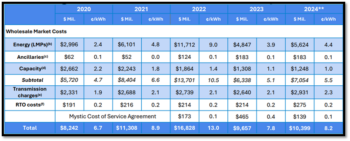
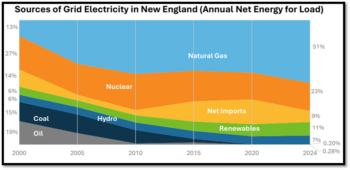
The takeaway for the region remains true: New England has a once-in-a-generation opportunity to redesign and revolutionize its energy system with clean energy and localize the job-creation and GDP impact of energy expenditures within the regional economy, rather than export them afar. Right now, the region has almost all its eggs in the fossil fuel basket, and this offers only the false promise of fool’s gold in protecting the region’s consumers from rising energy bills. The region must double down on its climate and clean energy goals to make the broader northeast region energy independent from fossil fuels, reduce consumer price spikes, and mitigate the economic harms of worsening climate change.
It’s time to set the record straight once again:
False claim #1: the region’s aggressive renewable climate energy policies are a major driver of high utility bills in New England.
Don’t let them fool you: New England spends $76b per year on energy, the majority of which still goes to fossil fuels from outside the region (source: EIA data for 2022). Plus, it was very, very cold this winter; the coldest winter since 2014-2015, in fact.[1] According to data compiled by Acadia Center (see figure 3 and 4 below), the average temperature in December 2024 was a full 10°F colder than December 2023. Further, from December 2024 through February 2025, Massachusetts saw 23 days colder than 20°F, compared to only nine such days the year prior. These colder temperatures generally mean that residents are using more energy, driving up bills.
Figures 3 and 4: Quantifying Winter 2024-2025 Cold Intensity (source: Acadia Center)
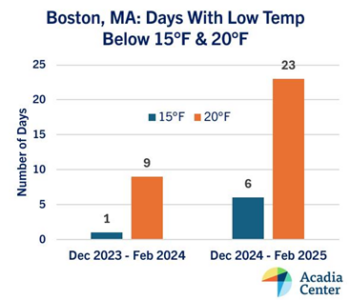
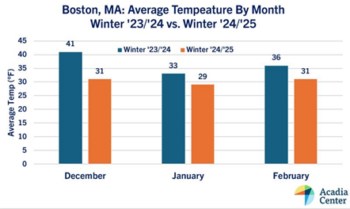
However, due to the Commonwealth’s overreliance on natural gas and other fossil fuels, it also means higher costs for the supply of energy. As America exports more liquefied natural gas (LNG) abroad, domestic gas prices are increasingly tied to the unpredictability of global gas markets, leading to increased price volatility for consumers. By contrast, renewable energy contracts provide a means of locking in affordable prices/rates over a long period of time, helping hedge and insulate the region from the volatile swings in fossil fuel commodity prices seen this winter. Had the Trump Administration not brought offshore wind development to a grinding halt, more high-value offshore wind resources would be available to mitigate winter price spikes and deliver much needed winter resource adequacy in the winters to come.
On the gas side, existing gas customers pay a disproportionate share of the costs for bringing new customers online. Since 2018, existing gas customers have footed the bill for 80% of all new gas customer connections. And these subsidies – known as line extension allowances – are driving up gas bills for everyone. In 2023 alone, Massachusetts gas customers were charged $160 million to add new customers to the gas system, to the tune of $9,000 per new customer, which is reflected on ratepayer gas bills. The cost of adding new customers is rising as well: the average cost of adding new customers rose 50% between 2020-2021 and again in 2022-2023. In fact, despite an acknowledgement by the state and by utilities that we should be winding the gas system down – not expanding it – the growth of the sprawling pipe network shows no signs of stopping. According to analysis from the Attorney General’s Office in Massachusetts, the path we’re currently on could see the state’s gas rate base – the total value of gas system assets on which utilities are allowed to earn a rate of return – jump from $10 to $20 billion in the span of roughly a decade, when factoring in the cost of new and replaced gas pipes.
Figure 5: Analysis of Growth Trajectory for Gas System Rate Base in MA (source: Joint Direct Testimony of Brattle Group on behalf of the MA Attorney General’s Office, DPU 24-GSEP-01, Feb. 2025)
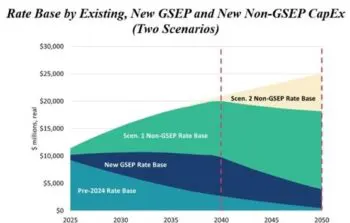
False claim #2: state laws requiring net zero by 2050, which are driving up costs for families and businesses.
As we wrote back in November, extensive modeling previously conducted by Massachusetts for the Commonwealth’s ‘2050 Decarbonization Roadmap’ and Clean Energy and Climate Plans (CECP) provide evidence for a much different trajectory for regional energy prices tied to achievement of 2050 climate targets. These studies included granular region-wide energy system modeling to arrive at their results for Massachusetts customers:
- The 2025/2030 CECP found: “The increased adoption of electrified transportation and heating systems means that the average Massachusetts household will spend less money on energy every year. Average overall household energy expenditures, which include transportation-related fuel costs (included as “energy” cost in this analysis), are projected to decline 8% by 2030 relative to 2019 levels, for an average household savings of $400 per year.”
- The 2050 CECP found: “the efficiency gains of electrification will result in lower household energy expenditures through 2050 (monthly bills for electricity and fuels). Transportation and household-related electricity and fuel expenditures are projected to decline by roughly 13% between 2030 and 2050, representing an average of nearly $600 (in 2021 dollars) in 2050 compared to 2030.
We also have to remember: pathways that invest in local energy resources, including renewable electricity generation and energy efficiency, create more jobs and demonstrate greater economic benefits by keeping money local compared to pathways more reliant on imported energy. For example, the “All Options” pathway from the Massachusetts 2050 Decarbonization Roadmap Study Economic and Health Impacts Report (which emphasized deep electrification and broad renewable electricity buildout) had 17% higher economic “output” (the broadest measure of economic activity) in Massachusetts per dollar invested than the “Pipeline Gas” pathway (which relied heavily on imported alternative fuels). Evidence of these benefits in action is highlighted throughout state clean energy industry reports conducted regularly, such as in Massachusetts, where in 2022, the industry contributed over $14b to Gross State Product, and in Maine, where the clean energy economy now accounts for over 2% of the state’s total workforce, more than 15,000 jobs.
False claim #3: energy efficiency programs are the culprit for rising energy bills this winter.
In response to complaints about energy affordability, some have blamed increased funding of the region’s cost-effective energy efficiency programs. This is no small source of irony – Mass Save®, for example, is a relatively small fraction of bills, but it is the most potent tool available to empower consumers to control their energy costs and protect them from fossil fuel price spikes. The vast majority of the bill for gas customers, around 70-75%, goes toward natural gas costs – relating to gas supply, distribution, and maintenance, compared to just 15-25% going toward energy efficiency. A similar dynamic is true on the electric side, where energy efficiency programs also represent only a small fraction in bills compared to fossil fuel and poles/wires costs: based on a recent bill from an Acadia Center staffer in Massachusetts, efficiency accounts for around 9% of a total National Grid electric bill.
Figure 6: Breakdown of Monthly Gas Bill for Massachusetts Customer in February (source: Eversource)
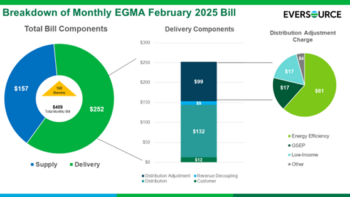
Unlike other energy costs, efficiency is the only investment that is required to pass cost-effectiveness testing. In fact, overall system costs would be billions of dollars greater without the cost reductions secured with efficiency; the more the benefits of improved energy efficiency are reduced, the costlier our energy system becomes.
Figure 7: Benefits of Current Three-Year Energy Efficiency Plans by State (source: Acadia Center)
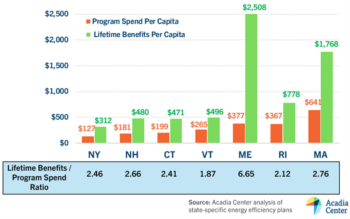
We should be investing even more to give homeowners, renters, and small businesses more tools to control their energy use and utility bills by increasing access to energy efficiency and implementing time-of-use (TOU) rates, plus expanding offerings for demand response and battery storage – which serve as far more cost-effective solutions for peak demand periods than the enormously costly reliability-must-run (RMR) contracts with fossil fuel power plants that ratepayers have had to bear in recent years. Increased oversight and accountability of utility distribution costs can also help drive savings for ratepayers, including via performance-based regulatory approaches to reduce inefficiencies and align incentives.
Looking back over time, the enormous benefits of the region’s energy efficiency benefits are self-evident. They have provided, as recently as 2023, 15% of gross electricity load for the entire region over the course of the year. In this way, energy efficiency helps meet the energy needs of our grid much in the same way as traditional supply resources like gas, oil, and coal. At the end of the day, the lowest-cost source of electricity is the one we never use.
Figure 8: Historic Benefits of NE Energy Efficiency Programs, 2012-2023 (source: Acadia Center)
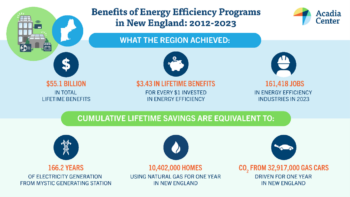
[1] https://www.nbcboston.com/weather/stories-weather/boston-total-snowfall-this-winter/3636399/
Maine GOP lawmakers, think tanks blame alt. energy ‘mandates’ for rising costs
Some right-leaning groups are blaming alternative energy for rising rates.
A group of Republican lawmakers from Maine and across New England as well as members of conservative think tanks held a virtual meeting on Tuesday to say “net zero policies” and “energy mandates” are driving up energy costs, squeezing homeowners, and forcing small businesses to absorb price increases.
Clean energy advocates, including Acadia Center, say the group is making false claims.
They say most of the energy in New England comes from fossil fuels and electric energy is projected to bring down costs in the years ahead.
Acadia Center writes in part:
“Fossil fuel-interest think tanks are back with a new round of the same tired and misguided attacks against clean energy policies in New England.”
To read the full article from WGME, click here.
High Energy Costs in the Northeast Fuel Innovation
Saving energy is big business in the Northeast, where electricity costs are 70 percent higher than the U.S. average as of February 2025. In addition to high costs, there’s also increasing demand for electricity in New England, which is expected to grow by about 17 percent from 2024 to 2033, and in New York, where it might nearly double by 2042. On top of that, the Northeast grid is expected to be at “elevated risk” for winter shortfalls of electricity, says the North American Electric Reliability Corporation.
Numbers like these mean that reducing energy consumption and being more energy efficient is imperative for homeowners and businesses in the Northeast.
“States in the Northeast are embracing the transition to a clean energy future for a number of important economic and consumer reasons,” says Daniel L. Sosland, 65, president of the Acadia Center, a nonprofit organization that promotes clean energy policies at the state and regional levels. “This region does not produce fossil fuels, but it does have abundant renewable energy resources. It also has the oldest building stock in the country, and the highest reliance on traditional heating fuels like oil.”
To read the full article from Inc. Magazine, click here.


















